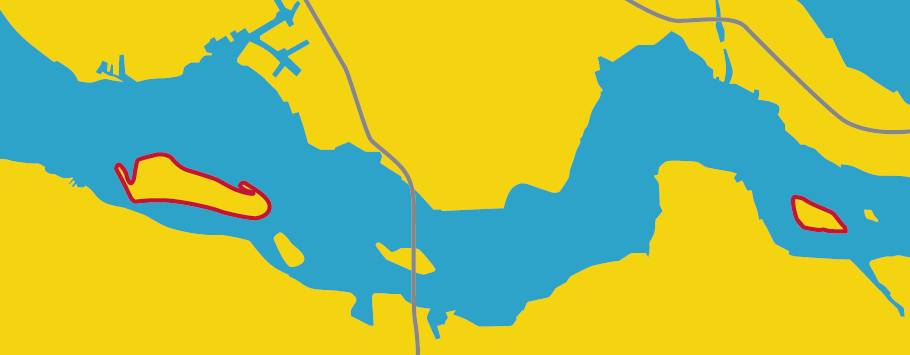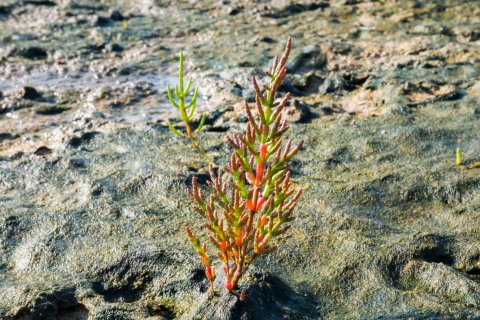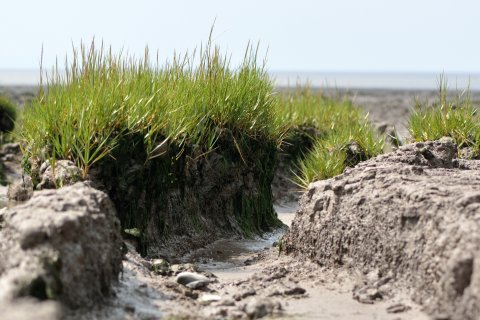New insights into the dominant role of plant growth in shaping landscapes of coastal areas
Publication in Nature Geoscience
The interaction between plant characteristics, flowing water and the transport of sand and silt play a dominant role in the creation of the landscapes typical of coastal areas. This ground-breaking conclusion by a team of international scientists from Utrecht University, the Royal Netherlands Institute for Sea Research (NIOZ), and the University of Antwerp was published in the prestigious journal Nature Geoscience. The physical characteristics of the plants (the thickness of their roots and stems, size, etc.) are important factors. However, the manner in which the plants settle and spread (their colonisation behaviour) is even more important in determining the appearance of the landscape. This research is interesting not only to biologists and physical geographers, but is also highly valuable to coastal managers and hydrological engineers who want to build with nature as a means of coastal defence.

The researchers examined the colonisation behaviour of coastal vegetation, especially pioneer species, and concluded that the speed at which pioneer plants colonise plays a major role in the formation of the landscape. This is not only interesting from a purely scientific perspective. Research leader Christian Schwarz (Utrecht University, Department of Physical Geography) explains: “Climate change leads to changes in plant species and thus plant colonization. With our new insights we can predict that this will also result in the formation of different coastal landscapes. We have already observed a shift in the coastal vegetation around the Mediterranean Sea. When you understand how organisms and their environment interact, you gain a better understanding of why our current coastal areas look as they do today, and how they will develop under the influence of climate change in the future.” In other words, coastal management and preservation depend on a thorough understanding of the role that plants play in changing landscapes.
Fast and slow colonisers
Schwarz emphasises that the changing processes aren’t necessarily a bad thing. To him, the important thing is to contribute to a better understanding of coastal landscape development, and the role that plant colonisation plays in the process. “Pioneers colonise the land at different speeds. Some plants are fast colonisers, and some are slow. The fast colonisers display a more even pattern of growth, while the slow colonisers provide more irregular ground cover. In the first group existing landscape forms are maintained, while at the second group, the slow colonisers, the development of all sorts of new forms and patterns in the landscape is facilitated. This results in more and deeper channels than where the pioneer vegetation only consists of fast colonisers. And those channels have a major influence on the landscape, including the coastal area’s ability to maintain itself as sea levels rise.”
Previous research has shown that fast colonisers increase the likelihood of the loss of coastal systems. “We also know that the size and shape of the channels affects the transport of sediment and nutrients, and therefore the ability of coastal marshes to grow as the sea level rises. But our research has now shown that fast and slow colonisers each play their own role in the formation of the channels, and therefore make an important contribution to whether or not the coastal landscapes can remain climate-resilient over time.”
Applicable around the world
For this study, the researchers used models, which they then compared to the existing situation at two salt marshes in the Westerscheldt estuary (southwestern Netherlands): the Hooge Platen and the Plaat van Walsoorden. This involved using remote sensing technologies, including aerial photography. Their models can be used anywhere around the world.


The first area was dominated by the fast coloniser glasswort (Salicornea europaea), and in the second the common cordgrass (Spartina anglica), a slow coloniser, was more dominant. Both areas displayed strong similarities in their tidal water level fluctuations and soil conditions, but the landscapes were dramatically different. This indicates that the colonisation behaviour of pioneer species plays a crucial role in the development of the landscape. Researchers in other parts of the world have reported similar differences.

Building with nature
The research by Schwarz and his colleagues contributes to the broader scientific debate on the relationship between landscape formation and plant growth. The practical application of their research is linked to the ‘building with nature’ concept, in which nature lends a hand in combating the negative consequences of climate change. Building with nature can also be applied to countless other human interventions in the coastal environment, as exemplified by the ‘sand engine’ off the coast of the province of South Holland. As sea levels are predicted to continue rising, it is vital that more sustainable, nature-oriented solutions are found for coastal management, and a better understanding of the role that plants play in changes in the coastal landscape is therefore vital.
Would you like to know more?
The study on the interaction between plant colonisation and landscape formation: Christian Schwarz et al., ‘Self-organization of a bio-geomorphic landscape controlled by plant life history traits’ has been published on the Nature Geoscience website.
The research by the Department of Physical Geography at Utrecht University falls under the university’s strategic research theme ‘Pathways to Sustainability’. In this research theme, scientists from a wide range of disciplines work together to build a sustainable future.

